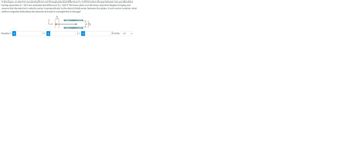
College Physics
11th Edition
ISBN: 9781305952300
Author: Raymond A. Serway, Chris Vuille
Publisher: Cengage Learning
expand_more
expand_more
format_list_bulleted
Concept explainers
Question

Transcribed Image Text:In the figure, an electron accelerated from rest through potential difference V₁=1.04 kV enters the gap between two parallel plates
having separation d = 18.5 mm and potential difference V₂= 102 V. The lower plate is at the lower potential. Neglect fringing and
assume that the electron's velocity vector is perpendicular to the electric field vector between the plates. In unit-vector notation, what
uniform magnetic field allows the electron to travel in a straight line in the gap?
Number ( i
î+
i
·x
+
Ta}m₂
d V₂
k) Units
J/T
Expert Solution
This question has been solved!
Explore an expertly crafted, step-by-step solution for a thorough understanding of key concepts.
Step by stepSolved in 4 steps with 4 images

Knowledge Booster
Learn more about
Need a deep-dive on the concept behind this application? Look no further. Learn more about this topic, physics and related others by exploring similar questions and additional content below.Similar questions
- Problem 5: An electron (q= -e = -1.60 × 10-19 C and me = 9.11 × 10-31 kg) in a cathode-ray tube is accelerated through a potential difference of 10 kV. Thus, the electron leaves the cathode-ray tube with a speed v = 5.93 × 107 m/sec. The electron then passes through the 2.0 cm wide region of uniform magnetic field (shown in the Figure above on the right). What field strength will deflect the electron by 10°? Answer: B = 0.0029 T. OV 10 kV 2.0 cm 10°arrow_forwardIn the figure, an electron accelerated from rest through potential difference V₁-1.12 kV enters the gap between two parallel plates having separation d = 21.0 mm and potential difference V₂= 129 V. The lower plate is at the lower potential. Neglect fringing and assume that the electron's velocity vector is perpendicular to the electric field vector between the plates. In unit-vector notation, what uniform magnetic field allows the electron to travel in a straight line in the gap? Number ( i + k) Unitsarrow_forwardA small rod magnet has a magnetic field at a distance from it as large as Hom B = 2nz3 Where z is the distance from the magnet on the axis connecting the north pole and south, m is the moment of magnetic dipole. Assuming electrons orbit protons like small rod magnets, determine the m magnetic dipole of an electron orbiting an atom.arrow_forward
- An electron is launched at a speed of v at an angle of 0 north of east into a region with a uniform magnetic field. The magnitude of the magnetic field is B and the field is pointing due east. a) Find the radius of curvature of the trajectory. b) Find the pitch (the distance traveled during one revolution, perpendicular to the plane of circular motion) of the trajectory.arrow_forwardAn electron in the beam of a cathod-ray tube is accelerated by a potential difference of 2.14 kV . Then it passes through a region of transverse magnetic field, where it moves in a circular arc with a radius of 0.190 m . What is the magnitude of the field?arrow_forwardAn electron initially at rest is accelerated through a potential difference of 3 kV in the positive x- direction. It enters a region where a uniform magnetic field of 5.0-mT is in a positive y-direction (perpendicular to the velocity of the electron). Calculate the radius of the path this electron will follow in the magnetic field. (e = 1.60 × 10-19 c, m electron = 9.11 × 10¯31 kg)arrow_forward
- An electron that has velocity т i = (2.0 x 106)i+ (3.0 × 106 10", %3D moves through the uniform magnetic field B = (0.030 T)î – (0.15T)f. (a) Find the force on the electron due to the magnetic field. (b) Repeat your calculation for a proton having the same velocity.arrow_forwardAn electron is accelerated through 2500 V from rest and then enters a region where there is a uniform 1.60 T magnetic field. What are the maximum and minimum magnitudes of the magnetic force acting on this electron?arrow_forwardA oxygen ion with a -2 charge is traveling in the +z direction. It enters a region of uniform magnetic field that points to the -y direction. When the ion enters this region, which direction will it be deflected?arrow_forward
arrow_back_ios
arrow_forward_ios
Recommended textbooks for you
 College PhysicsPhysicsISBN:9781305952300Author:Raymond A. Serway, Chris VuillePublisher:Cengage Learning
College PhysicsPhysicsISBN:9781305952300Author:Raymond A. Serway, Chris VuillePublisher:Cengage Learning University Physics (14th Edition)PhysicsISBN:9780133969290Author:Hugh D. Young, Roger A. FreedmanPublisher:PEARSON
University Physics (14th Edition)PhysicsISBN:9780133969290Author:Hugh D. Young, Roger A. FreedmanPublisher:PEARSON Introduction To Quantum MechanicsPhysicsISBN:9781107189638Author:Griffiths, David J., Schroeter, Darrell F.Publisher:Cambridge University Press
Introduction To Quantum MechanicsPhysicsISBN:9781107189638Author:Griffiths, David J., Schroeter, Darrell F.Publisher:Cambridge University Press Physics for Scientists and EngineersPhysicsISBN:9781337553278Author:Raymond A. Serway, John W. JewettPublisher:Cengage Learning
Physics for Scientists and EngineersPhysicsISBN:9781337553278Author:Raymond A. Serway, John W. JewettPublisher:Cengage Learning Lecture- Tutorials for Introductory AstronomyPhysicsISBN:9780321820464Author:Edward E. Prather, Tim P. Slater, Jeff P. Adams, Gina BrissendenPublisher:Addison-Wesley
Lecture- Tutorials for Introductory AstronomyPhysicsISBN:9780321820464Author:Edward E. Prather, Tim P. Slater, Jeff P. Adams, Gina BrissendenPublisher:Addison-Wesley College Physics: A Strategic Approach (4th Editio...PhysicsISBN:9780134609034Author:Randall D. Knight (Professor Emeritus), Brian Jones, Stuart FieldPublisher:PEARSON
College Physics: A Strategic Approach (4th Editio...PhysicsISBN:9780134609034Author:Randall D. Knight (Professor Emeritus), Brian Jones, Stuart FieldPublisher:PEARSON

College Physics
Physics
ISBN:9781305952300
Author:Raymond A. Serway, Chris Vuille
Publisher:Cengage Learning

University Physics (14th Edition)
Physics
ISBN:9780133969290
Author:Hugh D. Young, Roger A. Freedman
Publisher:PEARSON

Introduction To Quantum Mechanics
Physics
ISBN:9781107189638
Author:Griffiths, David J., Schroeter, Darrell F.
Publisher:Cambridge University Press

Physics for Scientists and Engineers
Physics
ISBN:9781337553278
Author:Raymond A. Serway, John W. Jewett
Publisher:Cengage Learning

Lecture- Tutorials for Introductory Astronomy
Physics
ISBN:9780321820464
Author:Edward E. Prather, Tim P. Slater, Jeff P. Adams, Gina Brissenden
Publisher:Addison-Wesley

College Physics: A Strategic Approach (4th Editio...
Physics
ISBN:9780134609034
Author:Randall D. Knight (Professor Emeritus), Brian Jones, Stuart Field
Publisher:PEARSON